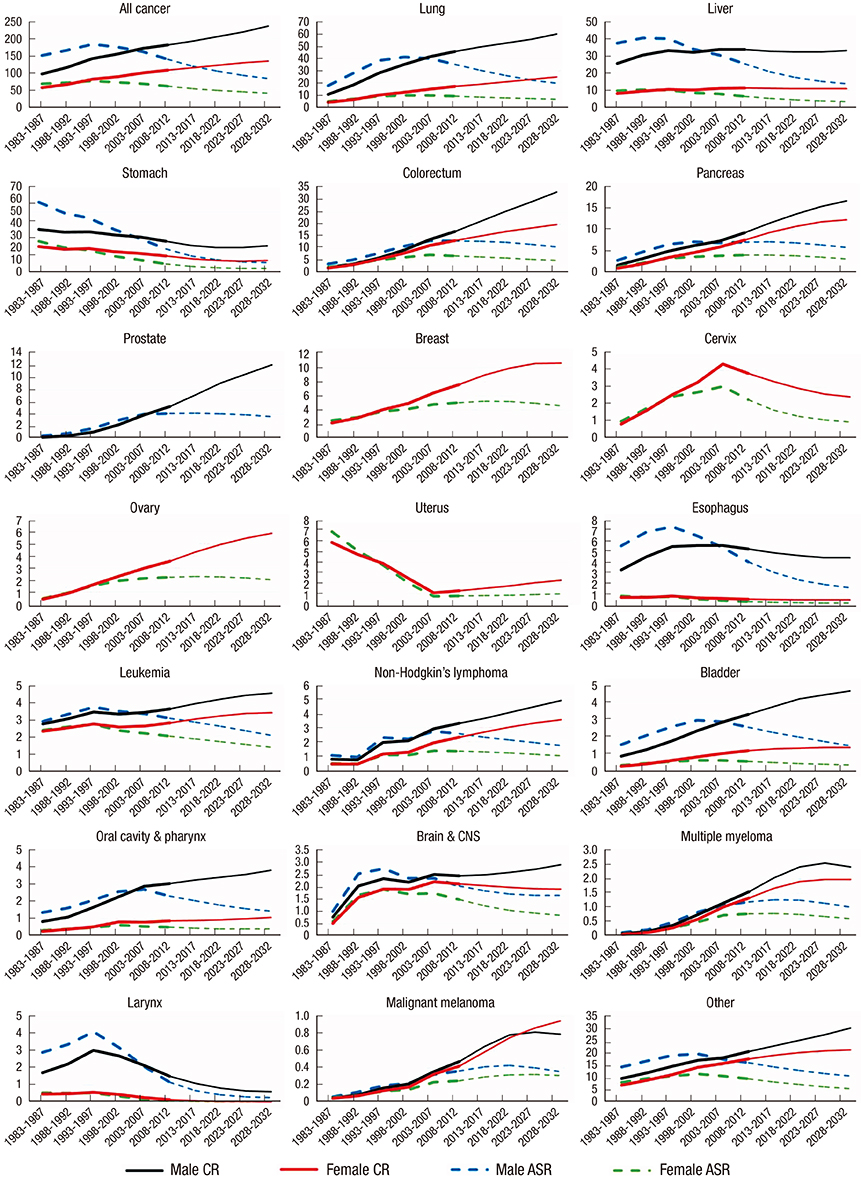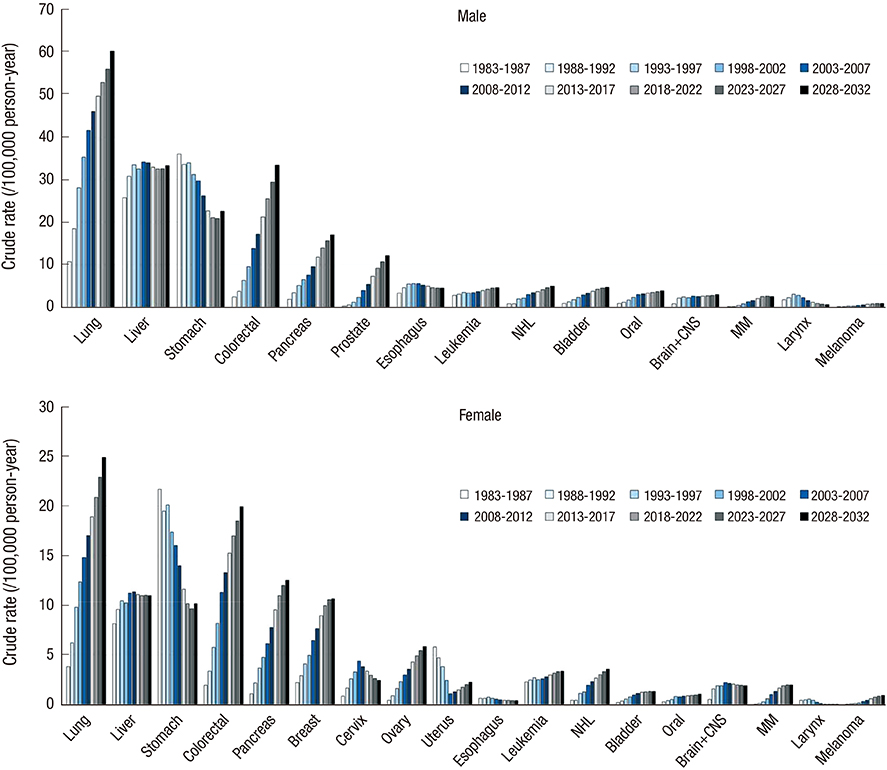J Korean Med Sci.
2016 Jun;31(6):892-901. 10.3346/jkms.2016.31.6.892.
Cancer Mortality Projections in Korea up to 2032
- Affiliations
-
- 1Department of Preventive Medicine, School of Medicine, Kangwon National University, Chuncheon, Korea. jwmdphd@daum.net
- KMID: 2373698
- DOI: http://doi.org/10.3346/jkms.2016.31.6.892
Abstract
- Predicting cancer mortality is important to estimate the needs of cancer-related services and to prevent cancer. Despite its significance, a long-term future projection of cancer mortality has not been conducted; therefore, our objective was to estimate future cancer mortality in Korea by cancer site through 2032. The specially designed Nordpred software was used to estimate cancer mortality. The cancer death data from 1983 to 2012 and the population projection data from 1983 to 2032 were obtained from the Korean National Statistics Office. Based on our analysis, age-standardized rates with the world standard population of all cancer deaths were estimated to decline from 2008-2012 to 2028-2032 (men: -39.8%, women: -33.1%). However, the crude rates are predicted to rise (men: 29.8%, women: 24.4%), and the overall number of the cancer deaths is also estimated to increase (men: 35.5%, women: 32.3%). Several cancer deaths are projected to increase (lung, liver and gallbladder, colon and rectum, pancreas and leukemia in both sexes; prostate cancer in men; and breast and ovarian cancer in women), whereas other cancer deaths are expected to decrease (stomach, esophagus and larynx in both sexes and cervical cancer in women). The largest contribution to increasing cancer deaths is due to the aging of the Korean population. In conclusion, a strategy for primary prevention, early detection, and early treatment to cope with the rapidly increasing death of cancer due to population aging is urgently required.
Keyword
MeSH Terms
Figure
Cited by 2 articles
-
Trends in Cardiovascular Complications and Mortality among Patients with Diabetes in South Korea
Jung Hwan Park, Kyoung Hwa Ha, Bo Yeon Kim, Jae Hyuk Lee, Dae Jung Kim
Diabetes Metab J. 2021;45(1):120-124. doi: 10.4093/dmj.2020.0175.Promoter-Specific Variants in NeuroD1 and H3K4me3 Coincident Regions and Clinical Outcomes of Small Cell Lung Cancer
Seung Soo Yoo, Sunwoong Lee, Jin Eun Choi, Mi Jeong Hong, Sook Kyung Do, Jang Hyuck Lee, Won Kee Lee, Ji Eun Park, Yong Hoon Lee, Sun Ha Choi, Hyewon Seo, Jaehee Lee, Shin Yup Lee, Seung Ick Cha, Chang Ho Kim, Hyo-Gyoung Kang, Jae Yong Park
J Korean Med Sci. 2023;38(45):e381. doi: 10.3346/jkms.2023.38.e381.
Reference
-
1. Møller B, Fekjaer H, Hakulinen T, Tryggvadóttir L, Storm HH, Talbäck M, Haldorsen T. Prediction of cancer incidence in the Nordic countries up to the year 2020. Eur J Cancer Prev. 2002; 11:Suppl 1. S1–96.2. Møller B, Fekjaer H, Hakulinen T, Sigvaldason H, Storm HH, Talbäck M, Haldorsen T. Prediction of cancer incidence in the Nordic countries: empirical comparison of different approaches. Stat Med. 2003; 22:2751–2766.3. Møller H, Fairley L, Coupland V, Okello C, Green M, Forman D, Møller B, Bray F. The future burden of cancer in England: incidence and numbers of new patients in 2020. Br J Cancer. 2007; 96:1484–1488.4. Olsen AH, Parkin DM, Sasieni P. Cancer mortality in the United Kingdom: projections to the year 2025. Br J Cancer. 2008; 99:1549–1554.5. Mistry M, Parkin DM, Ahmad AS, Sasieni P. Cancer incidence in the United Kingdom: projections to the year 2030. Br J Cancer. 2011; 105:1795–1803.6. Nowatzki J, Moller B, Demers A. Projection of future cancer incidence and new cancer cases in Manitoba, 2006-2025. Chronic Dis Can. 2011; 31:71–78.7. Rapiti E, Guarnori S, Pastoors B, Miralbell R, Usel M. Planning for the future: cancer incidence projections in Switzerland up to 2019. BMC Public Health. 2014; 14:102.8. Weir HK, Thompson TD, Soman A, Møller B, Leadbetter S. The past, present, and future of cancer incidence in the United States: 1975 through 2020. Cancer. 2015; 121:1827–1837.9. Jung KW, Won YJ, Oh CM, Kong HJ, Cho H, Lee DH, Lee KH. Prediction of cancer incidence and mortality in Korea, 2015. Cancer Res Treat. 2015; 47:142–148.10. Segi M. Cancer Mortality for Selected Sites in 24 Countries. Nagoya: Japan Cancer Society;1969.11. Ahmad OB, Boschi-Pinto C, Lopez AD, Murray CJ, Lozano R, Inoue M. Age Standardization of Rates: a New WHO Standard. Geneva: World Health Organization;2001.12. Statistics Korea. Smoking prevalence. accessed on 1 February 2016. Available at http://kosis.kr/statHtml/statHtml.do?orgId=101&tblId=DT_2KAAC04&conn_path=I2.13. Park S, Jee SH, Shin HR, Park EH, Shin A, Jung KW, Hwang SS, Cha ES, Yun YH, Park SK, et al. Attributable fraction of tobacco smoking on cancer using population-based nationwide cancer incidence and mortality data in Korea. BMC Cancer. 2014; 14:406.14. Shin A, Kim KZ, Jung KW, Park S, Won YJ, Kim J, Kim DY, Oh JH. Increasing trend of colorectal cancer incidence in Korea, 1999-2009. Cancer Res Treat. 2012; 44:219–226.15. Lee WJ. Epidemiology and risk factors in pancreatic cancer. Korean J Hepatobiliary Pancreat Surg. 2004; 8:61–68.16. Yancik R, Ries LG, Yates JW. Breast cancer in aging women. A population-based study of contrasts in stage, surgery, and survival. Cancer. 1989; 63:976–981.17. Statistics Korea. Death cause statistics. accessed on 1 February 2016. Available at http://kosis.kr/statHtml/statHtml.do?orgId=101&tblId=DT_1B80A13&conn_path=I2.18. Henderson BE, Ross R, Bernstein L. Estrogens as a cause of human cancer: the Richard and Hinda Rosenthal Foundation award lecture. Cancer Res. 1988; 48:246–253.19. Song IH, Kim KS. Current status of liver diseases in Korea: hepatocellular carcinoma. Korean J Hepatol. 2009; 15:Suppl 6. S50–9.20. Bouvard V, Baan R, Straif K, Grosse Y, Secretan B, El Ghissassi F, Benbrahim-Tallaa L, Guha N, Freeman C, Galichet L, et al. A review of human carcinogens--Part B: biological agents. Lancet Oncol. 2009; 10:321–322.21. Park NH, Chung YH, Lee HS. Impacts of vaccination on hepatitis B viral infections in Korea over a 25-year period. Intervirology. 2010; 53:20–28.22. Choi KS, Jun JK, Suh M, Park B, Noh DK, Song SH, Jung KW, Lee HY, Choi IJ, Park EC. Effect of endoscopy screening on stage at gastric cancer diagnosis: results of the National Cancer Screening Programme in Korea. Br J Cancer. 2015; 112:608–612.23. Shin A, Kim J, Park S. Gastric cancer epidemiology in Korea. J Gastric Cancer. 2011; 11:135–140.24. Yim JY, Kim N, Choi SH, Kim YS, Cho KR, Kim SS, Seo GS, Kim HU, Baik GH, Sin CS, et al. Seroprevalence of Helicobacter pylori in South Korea. Helicobacter. 2007; 12:333–340.25. Kang KJ, Lee JH. Characteristics of gastric cancer in Korea - with an emphasis on the increase of the early gastric cancer (EGC). J Korean Med Assoc. 2010; 53:283–289.26. Song J, Hyung WJ. Robotic surgery for early gastric cancer. J Korean Med Assoc. 2010; 53:318–323.27. Kim N. Screening and diagnosis of early gastric cancer. J Korean Med Assoc. 2010; 53:290–298.28. Yang JI. A study of esophageal cancer detected by screening upper endoscopy for a routine health check-up. Korean J Helicobacter Up Gastrointest Res. 2013; 13:99–103.29. Kim YT. Current status of cervical cancer and HPV infection in Korea. J Gynecol Oncol. 2009; 20:1–7.30. Park Y, Vongdala C, Kim J, Ki M. Changing trends in the incidence (1999-2011) and mortality (1983-2013) of cervical cancer in the Republic of Korea. Epidemiol Health. 2015; 37:e2015024.31. Jun JK, Choi KS, Jung KW, Lee HY, Gapstur SM, Park EC, Yoo KY. Effectiveness of an organized cervical cancer screening program in Korea: results from a cohort study. Int J Cancer. 2009; 124:188–193.
- Full Text Links
- Actions
-
Cited
- CITED
-
- Close
- Share
- Similar articles
-
- Forecasting Cause-Specific Mortality in Korea up to Year 2032
- Estimation of Supply and Demand for Cardiologists in Korea
- Incidence and mortality projections for major cancers among Korean men until 2034, with a focus on prostate cancer
- Cone-beam Reconstruction using Limited EPID Projections for Seeds Localization
- The Upper Ascending Reticular Activating System between Intralaminar Thalamic Nuclei and Cerebral Cortex in the Human Brain




